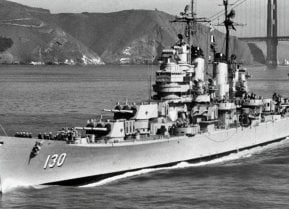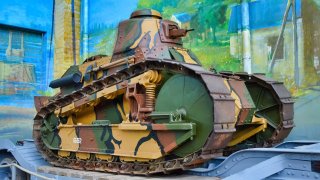Renault FT: This Just Might Be the Best Tank Ever
Considering the past 100+ years of tank warfare, there have been numerous tanks that were the best of their time, but when it comes to lasting impact in tank design and innovation nothing quite compares to the Renault FT, the French light tank developed during the First World War.
Why The Renault FT Is Truly the Best Tank Ever: When it comes to sports and entertainment, the debate over GOAT (Greatest Of All Time) will never be truly settled. Sonny Liston or Muhammad Ali, Babe Ruth or Alex Rodriguez, Jimi Hendrix or Jimmy Page, Laurence Olivier or Tom Hanks – the list can continue on and on. But in the world of military hardware, the debate for the best is a little harder to narrow down, especially when it comes to tanks.
It is true that the T-34 may have been the best tank of the Second World War, but it would hardly be able to take on a contemporary Leopard 2 or M1A2 Abrams. The M4 Sherman had more total kills in the war than the King Tiger, but the Sherman had the numbers on its side.
It is far easier in fact, to determine the worst tanks. Seeing shortcomings and failures in military hardware is far easier to quantify, while a failure of tactics also needs to be considered. That is why the M3 Sherman proved a success, even when it was outgunned and outclassed.
Best Tank Ever: The Case for the Renault FT
Considering the past 100+ years of tank warfare, there have been numerous tanks that were the best of their time, but when it comes to lasting impact in tank design and innovation nothing quite compares to the Renault FT, the French light tank developed during the First World War.
It was quite unique at the time.
The British military, which had been the first to employ a "tank" on the battlefield, had initially envisioned a "landship" that could roll across the trenches. When that proved to be too ambitious, it was scaled back significantly. Yet, the first tanks were still something more comparable to a naval ironclad than what we think of today as a tank.
The British first tank employed in combat – dubbed simply the MkI – was a massive 28-ton behemoth that featured the main armament in sponsons on the hull sides. The crew of eight, which included the commander, driver, two gearsmen and four gunners, shared the same compartment as the engine. The environment inside, which lacked proper ventilation, was unpleasant and downright dangerous as the crew was exposed to both carbon monoxide, fuel and oil vapors, and cordite fumes from the weapons.
Germany countered with an even more massive tank, the A7V. At 31.5 tons it was the largest land vehicle built during the war, and it required a crew of nearly 20.
Meanwhile, the French Army went the other direction and developed a 6.5 ton light tank. It was revolutionary in that it was the first to have its armament within a fully rotating turret. The FT was designed by French tank pioneer, Jean-Baptiste Estienne, who sought to develop an armored vehicle that had a power-to-weight ratio good enough to overcome trenches and shell craters.
It also featured different compartments for the engine and gearbox, located in the rear of the tank, while the two man crew (commander/gunner and driver) was positioned at the front. The FT was arguably the first modern tank, and many of its features remain commonplace today. While fairly lightly armed, with either a single Puteaux SA 18 37 mm (1.45 in) short-barreled, low-velocity gun, or a coaxial Hotchkiss 7.92 mm (0.31 in) machine gun, the turret made it versatile and efficient in most circumstances.
In addition to the innovative features that Estinenne employed in his design, he also helped create modern tank doctrine, as he believed that the best way to overwhelm the enemy was for hundreds of tanks to "swarm across the battlefield like mosquitoes."
While only 3,000 of the Renault FTs were produced, it was widely exported in large numbers and copies were manufactured in the United States, Italy, and even the Soviet Union. It was considered obsolete by the outbreak of the Second World War, but its influence could be seen in the tanks that developed in the interwar era.
About the Author: Peter Suciu
A Forbes Magazine Contributing Writer, Peter Suciu is a Michigan-based writer who has contributed to more than four dozen magazines, newspapers and websites. He regularly writes about military small arms, and is the author of several books on military headgear including A Gallery of Military Headdress, which is available on Amazon.com.
Image Credit: Creative Commons.


